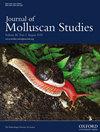Long-term relationships between the abundance of pest molluscs and weather in agricultural fields in South Australia
IF 1.2
4区 生物学
Q2 MARINE & FRESHWATER BIOLOGY
引用次数: 0
Abstract
Invasive snails, Cernuella virgata, Theba pisana and Cochlicella acuta, infest grain crops prior to harvest in early summer in southern Australia. They breed in autumn–early winter and peak in abundance in spring following the recruitment of young snails. Long-term studies (20 years) were established on three farms in South Australia (two practicing pasture–cereal rotations and one continuous cropping) to better understand the role of prevailing weather in driving the population dynamics of the three snail species and to develop predictive models that might assist farmers and off-farm grain handlers to anticipate future peaks in snail abundance and tailor their management practices accordingly. The three species are asynchronous in their population dynamics; they peak in numbers in different years. The abundance of C. virgata in late spring (preharvest) was most closely associated with, and could be broadly predicted by, the previous autumn to spring rainfall, but no significant associations were found between the rainfall and the abundance of C. acuta and T. pisana. Local air temperatures had little apparent association with the abundance of all three species. Broader scale weather, exemplified by the El Niño Southern Oscillation Index, was only occasionally, and weakly, related to the spring abundance of C. virgata.南澳大利亚农田中有害软体动物数量与天气之间的长期关系
入侵蜗牛,Cernuella virgata,Theba pisana和Cochlicella acuta,在澳大利亚南部初夏收获前侵扰粮食作物。它们在秋季——初冬繁殖,在春季招募年轻蜗牛后数量达到峰值。对南澳大利亚州的三个农场(两个牧场-谷物轮作和一个连作)进行了长期研究(20年),以更好地了解盛行天气在驱动三种蜗牛种群动态中的作用,并开发预测模型,帮助农民和非农场谷物加工商预测未来蜗牛数量的峰值并相应地调整其管理做法。这三个物种的种群动态是异步的;它们的数量在不同年份达到峰值。春末(采前)C.virgata的丰度与前一次秋季至春季的降雨关系最为密切,可以广泛预测,但降雨与C.acuta和T.pisana的丰度之间没有显著关联。当地气温与这三种物种的丰度几乎没有明显的联系。以厄尔尼诺南方涛动指数为例,更大范围的天气只是偶尔且微弱地与维尔加塔的春季丰度有关。
本文章由计算机程序翻译,如有差异,请以英文原文为准。
求助全文
约1分钟内获得全文
求助全文
来源期刊

Journal of Molluscan Studies
生物-动物学
CiteScore
3.00
自引率
8.30%
发文量
36
审稿时长
3 months
期刊介绍:
The Journal of Molluscan Studies accepts papers on all aspects of the study of molluscs. These include systematics, molecular genetics, palaeontology, ecology, evolution, and physiology. Where the topic is in a specialized field (e.g. parasitology, neurobiology, biochemistry, molecular biology), submissions will still be accepted as long as the mollusc is the principal focus of the study, and not incidental or simply a convenient experimental animal. Papers with a focus on fisheries biology, aquaculture, and control of molluscan pests will be accepted only if they include significant advances in molluscan biology. While systematic papers are encouraged, descriptions of single new taxa will only be considered if they include some ‘added value’, for example in the form of new information on anatomy or distribution, or if they are presented in the context of a systematic revision or phylogenetic analysis of the group.
 求助内容:
求助内容: 应助结果提醒方式:
应助结果提醒方式:


